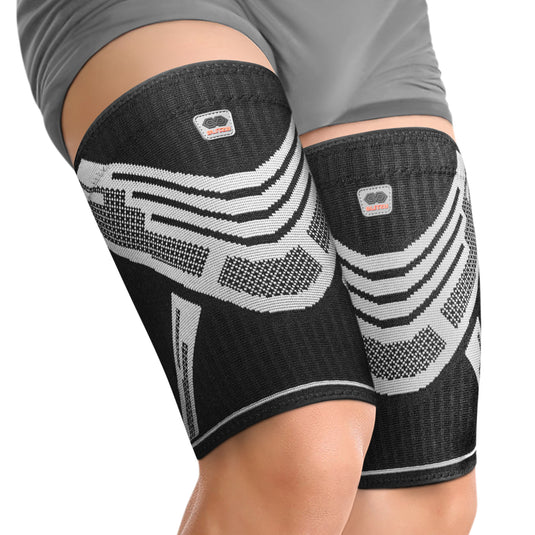Thigh & Hamstring Pain Treatment
Thigh pain can cause you to have difficulty walking, running, or climbing stairs. Sometimes inner thigh pain or upper thigh pain can occur after trauma or an injury. Other times, it may begin for no apparent reason.
Causes of Thigh Pain
Muscle sprains and strains
Sprains and strains can affect any of the many muscles, ligaments, and tendons in the thigh.
A sprain is a torn or stretched ligament. Ligaments connect bones to other bones.
A strain is a torn or stretched muscle or tendon. Tendons connect muscles to bones.
Symptoms of a strain or sprain include:
- sudden pain following a fall, an intense workout, or an overstretched joint
- pain that spreads (radiates) up or down
- difficulty stretching or moving the thigh
- swelling around the painful area
Injuries from overuse
Overuse injuries can occur when a muscle in or around the thigh is worked too hard for too long, or when a person does not warm up before exercise.
The pain tends to get worse with time. Eventually, the pain may occur even when a person rests the injured area.
The main sign of an overuse injury is pain following exercise or intense physical activity. The pain may affect both thighs.
Sedentary lifestyle
Not getting enough exercise or spending too much time sitting each day can damage the muscles, causing chronic pain.
Sitting for long periods can put pressure on the joints and muscles, particularly of the hips and legs. Lack of activity may also cause the muscles to weaken, triggering widespread muscle pain.
People who have upper thigh pain due to a sedentary lifestyle may also feel pain throughout their body. The pain can move or change in intensity over time, and some people with this type of pain may experience widespread chronic pain.
Radiating pain from another injury
Injuries in other areas of the body can cause pain to spread to the upper thighs. For instance, a hip injury may radiate down to the legs.
Some injuries change how a person walks, causing them to stiffen their muscles without realizing. This can cause pain in the thighs and legs. If a person feels pain in nearby areas, such as in the hips or knees, this could also be the reason why their thighs hurt.
Nerve pain
People may also experience pain from nerves in the upper thigh. Nerve pain occurs when there is damage to the nerves. This creates the feeling of pain even when there is not a physical injury to the thigh.
Some common types of nerve pain include:
Peripheral neuropathy
Peripheral neuropathy is nerve damage that causes nerve pain, such as diabetes.
People with this pain may experience unusual sensations in the thighs and elsewhere, including burning, numbness, prickly sensations, and shooting pains.
Meralgia paresthetica
Meralgia paresthetica is also called Bernhardt-Roth syndrome, a nerve that affects feeling in the outside of the thigh, can cause this painful sensation.
A person may experience this pain as burning or shooting, and the condition can cause periodic numbness in the upper thigh and hips.
Other causes
Minor injuries
A bruise, even one that is not visible, can be intensely painful. This pain is often throbbing and occurs in a single area.
Pain from a minor injury such as a bruise does not typically radiate elsewhere.
Chronic conditions
Numerous chronic conditions can cause pain in the upper thigh. People with fibromyalgia experience chronic widespread pain at specific pressure points. Leg pain often occurs just above the knees and on the back of the upper thighs.
Various types of arthritis can cause pain throughout the body, including in the thighs. The pain of osteoarthritis is often concentrated in the hip and knee joints but may radiate down or up.
Blood clots
Rarely, pain in the upper thigh can be due to a blood clot in a blood vessel. Also called deep vein thrombosis (DVT), this painful condition can become life-threatening if the clot breaks loose and travels to the lungs, heart, or brain.
People who take long flights, are sedentary for extended periods, have poor circulation, smoke, have cardiovascular disease, or are pregnant or overweight are at a high risk of developing DVT.
Symptoms include:
- unexplained pain in a leg that does not get better after a few days
- swelling, redness, or heat along a leg vein
- tenderness in a specific spot on the leg
- pain when walking
- shortness of breath when a clot breaks loose and moves to the heart and then to the lungs (pulmonary embolus)
A blood clot is a medical emergency that needs immediate medical treatment.
Prevention
Some steps that may help prevent upper thigh pain include:
- remaining physically active
- wear compression garments such as thigh sleeves or thigh brace
- taking frequent stretching breaks during extended periods of sitting
- stretching before and after exercise
- working with a personal trainer to determine a healthful level of activity that will not lead to overuse injuries
- managing and treating medical conditions, such as diabetes and arthritis

